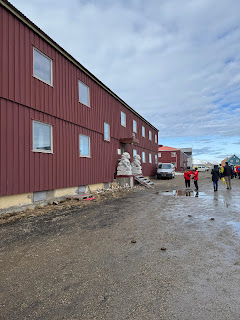NY-ALESUND OUR RETURN:
I am really glad we are making a stop at Ny-Alesund as it is steeped in so much Arctic History. In addition to all the history, it is a breeding ground for Arctic Tern, those dive bombing birds as they protect their territory. Yes they will bop you in the head as they dive bomb you.
I like the Arctic Tern mostly because they have one of the longest-known migratory routes of all animals. Terns nest in the Arctic and then travel south to Antarctica. Then they return the next year to nest. They can travel over 90,000 km (55,900 miles) per year. Arctic terns travel an estimated 2.4 million km (1.491 million miles) in their lifetimes. That's three round-trip flights to the Moon. Just AMAZING!!
Ny-Ålesund is the world’s northernmost settlement, situated at 79 degrees north in the north-western region of Spitsbergen, Svalbard. Ny-Ålesund can be found on the southern bank halfway inside Kongsfjorden (The King’s Fjord), and it was originally a coal mining settlement that was established in 1916. From the end of the 1960s, scientific research has been the main activity in Ny-Ålesund. At present time however, it is a research station with scientists from over 10 different countries which only has around 40 residents living there throughout the whole year. But in the summertime the population count can on occasion rise to around 150 people.
The general store/ shopping mall has post cards and souvenirs
The settlement has its own airport, harbor, a museum, the world’s northernmost post office and a souvenir shop. In the summertime one can travel to Ny-Ålesund with one day trips by boat from Longyearbyen, or one can visit as part of a longer multi-day trip with larger vessels. In the wintertime Ny-Ålesund is a stopping point for a few select skiing expeditions that are offered by various activity providers in Svalbard. There are no accommodation offers available for tourists in the settlement.
Ny-Ålesund is a settlement with an amazing history. In the period of 1917 to 1962, King’s Bay Coal Company ran mining operations in Ny-Ålesund. Throughout this period there were a number of accidents, and a total of 76 people lost their lives in mining related activities. What ultimately became the end of the mining community in Ny-Ålesund was the big mining accident on the 5th of November 1962. The accident claimed 21 lives in total. 10 bodies were possible to recover, while the remaining 11 got the mine as their final resting place.
Ny-Ålesund is also known as being the starting point for Roald Amundsen’s expeditions to the North Pole. You can still see the mooring mast that the airship “Norge” was docked with. This was also the starting point for the dramatic North Pole expedition of the Italian Umberto Nobile, whose airship crashed when returning from the pole point. Half of the onboard crew died in the crash, but Nobile miraculously survived the crash and was later rescued.
Amundsen was one of the searchers for Nobile and sadly disappeared during the search never to be found.
Ny-Ålesund has Svalbard's largest collection of automatically protected cultural heritage sites. 29 builidings in total, amounting to about half of all the buildings in the settlement, are protected. In addition, many remnants of the settlement's mining history are visible. This contributes towards making Ny-Ålesund a place of considerable value to visitors' experience in Svalbard.
Important information for visitors to Ny-Ålesund:
As a visitor in Ny-Ålesund, there are some rules one needs to be aware of: In the settlement and in a surrounding radius of 20km around Ny-Ålesund there's radio silence, meaning wifi and bluetooth must be turned off on mobile phones and other units. It's not allowed to use drones or other equipment (cameras, wristwatches etc.) with wifi turned on. This is due to The Norwegian Mapping Authority's (Kartverket) geodetic station just outside of the settlement which measures the earth's movements with very finely tuned and delicate instruments.
As a visitor in Ny-Ålesund, it's also important that one walks on the roads and wooden pathways, and not on the tundra. Biologists do research on the tundra and the birds that use it, and as such it's important to disturb the vegetation or wildlife as little as possible. In addition, there are many research installations placed in and around the settlement, so to be sure that one isn't ruining research findings one should stick to the roads.
We returned to the ship for lunch and then spent a good bit of time on the Deck 5 observation area as we sailed through some bergie bits near several glaciers. Really a nice slow sail.
We then went to the Explorers lounge and watch the beauty of Svalbard pass by as we sailed to Lilliehöökbreen glacier and is one of the largest glaciers of northwestern Spitsbergen. The impressive glacier front is an unbelievable 11 kilometers long (approximately, as of 2013). It has retreated strongly during the last century, as has been documented by Duke Albert I. of Monaco during his 1906 expedition in comparison to a 2006 visit of his grandson Duke Albert II.
Lilliehöökbreen is actually not an individual glacier, but a complex of more than 10 glaciers that unite to form one large, moving mass of ice.
We are being lazy and warm and decided not to go on the zodiac tour of the glacier. The ship is anchored really close.
There is an option for TakeAway Dining and we may just give that a try, Fish Burger or a Hamburger. The food is great but always way too much. Well for us it is.
Our plans for tomorrow are unknown at this time, so we shall see.


















No comments:
Post a Comment